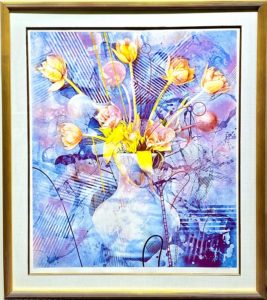Quality Fine Art Print Framing Solutions

“Rhapsody in Blue” Mixed-Media Serigraph by Yankel Ginzburg
When framing serigraphs or lithographs on paper, you must factor in the type of glass used, the kind of tape, proper matting and backing materials, as well as how and where it’s going to hang.
Glazing
Let’s start with glazing, the glass used in framing. At a minimum, any glass used must protect from UV (ultraviolet) light. UV rays will cause the art to fade. Serigraphs are much more resistant to fading than lithographs, yet all colors in any form are subject to fading. It is best to use ‘UV filtering glass’ for prints framed up to 40 x 60 inches. If your frame is larger, it is best to use a UV acrylic sheet which is also lighter in weight. Unfortunately, both products are highly ‘reflective’ (shiny) unless you use ‘Museum Glass’ or ‘Museum Acrylic,’ such as glazing manufactured by Tru Vue®. ‘Museum’ glazing not only filters out UV, but will eliminate most reflection. Museum Glass is by far the best glazing on the market at this time. If your print is exposed to UV light, you’ll want to avoid regular picture glass or regular clear acrylic as your art will fade over time. Any glazing with less than 97% UV protection will NOT keep your art from fading.
Matboards
Matboards prevent your art from touching the glass, which, if not separated, could cause condensation and/or mold to form between the print and the glass. This is one of many good reasons for going to a professional framer. He/she will make recommendations to safeguard your art.
The mat around your print is made of either wood pulp or cotton. Wood pulp contains acid that will eat away at your paper art, causing not only discoloration but also destroying the value of the art. Cotton-based, acid-free matboards provide the most protection. To give your art a more prominent and formal look, your framer may suggest a ‘filet,’ a small finished strip usually made from wood that sits on the inner edge of the mat. As with the matboard, this also needs to be acid-free. You will not be able to tell if it is, so you will need to trust your framer’s knowledge and experience that it has the proper treatment.
Tape
If you choose not to mat your print, make sure to use a spacer to create the air gap needed to keep your artwork from touching the glass. The backing material used behind your art and the type of tape used to secure the print must also be acid-free, or you will be compromising the integrity of the entire package.
Hanging Tools
What about the way you will hang your finished framed artwork? Your artwork will likely hang on your wall for a long time. If it is large and has a wire across the back, but the frame is not substantial enough, over time, the frame will start to bow where the hangers on the back are attached. If appropriate, you should only install frame hooks without wire. A quality framer will place a warning on the back of the artwork explaining why NOT to use a wire to connect the hooks. Using just hooks will let gravity keep your frame secure and free from bowing.
Location
Choosing the right location for hanging your art is also significant. Placing a frame on the inside surface of an exterior wall can be troublesome. The difference in temperatures from outside and inside can cause issues such as condensation. This placement, though not recommended, is often necessary and can’t be avoided. You will need to keep an eye on those pieces to ensure there are no signs of trouble like discoloration on the back or a change in the integrity of the frame. Visit your framer for a closer look to make sure there is no damage.

U. S. Senator Ben Cardin with Ginzburg Serigraph “Glorious Document”
In conclusion, you can see why choosing a quality, professional framer is so important. When one questions how a piece of framed art is aging, we recommend that you take it to a trusted professional framer to assess what the issue is and what to do about it. Keeping your artwork beautiful and well preserved will protect your investment and provide you with many years of enjoyment. One recognized expert ‘master framer’ with over 40 years of experience is Michael Sharp at www.sharpdesigns.biz .
Contact Zimmerman Fine Art Today!
Since 1979 Zimmerman Editions Ltd. has worked closely with many internationally acclaimed artists to execute editions of their most unique images. Collaborating directly with the artists, Zimmerman Editions’ atelier has printed, fabricated, and published many special limited editions of fine art, including both prints and sculptures. All images have been faithfully produced to meet the artists’ most exacting requirements. Many of these high-quality art prints and objets d’art are represented in public and private collections around the world.
If you are a fine art dealer or marketer, or interested in collecting contemporary fine art, contact us today through our short form or our number at 888-484-1850. For more about fine art, keep in touch through Facebook, Twitter, and LinkedIn!
